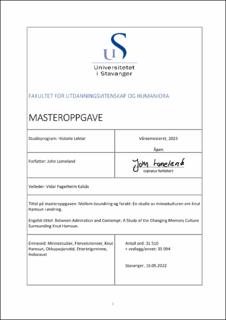| dc.description.abstract | I sine yngre dager var Knut Hamsun kjent som «Norges store sønn», i sine eldre dager var han kjent som «landssvikeren» og «fascisten». Siden da har spørsmålet og debatten om hvordan man skal minnes Knut Hamsun hyppig dukket opp i Norge.
I denne oppgaven utforsker jeg minnekulturen om Knut Hamsun, og hvilke kontinuitets- og endringsmønstre som er fremtredende. Gjennom en språklig analyse av biografier, bøker og aviser om Hamsun, har jeg pekt på sentrale endringer i argumentasjon og fortellingsmønstre i minnekulturen. Funnene av analysen vil bli sett i lys av et kontekstuelt bakteppe, hvor jeg ser Hamsuns minnekultur i lys av minnestudier om okkupasjonskrigen, det norske holocaust og flerveisminner.
Jeg argumenterer i oppgaven for en høy grad av samvariasjon mellom minnet om Hamsun og tendenser i utviklingen av det kollektive minnet om okkupasjonen og holocaust. Frem mot 70-tallet var Hamsuns minnekultur preget av økende apologetiske tendenser, mens man kan ane en økning av moraliserende tendenser fra tidlig 70-tall og til i dag. Ved å se min analyse i lys av tidligere forskning om okkupasjonstiden, kan den validere, kritisere og nyansere eksisterende teser. Derfor vil jeg argumentere at oppgaven er et viktig bidrag til feltet. | |
| dc.description.abstract | In his younger days, Knut Hamsun was known as "Norway's great son," but in his later years, he was known as a "traitor" and "the fascist." Since then, the question and debate about how to remember Knut Hamsun have frequently arisen in Norway.
In this thesis, I explore the culture of memory surrounding Knut Hamsun and the prominent patterns of continuity and change. Through a linguistic analysis of biographies, books, and newspapers about Hamsun, I will identify key changes in argumentation and narrative patterns in the memory culture. The findings of the analysis will be viewed in light of a contextual background, where Hamsun's memory culture is seen in the context of memorial studies of the occupation war, the Norwegian Holocaust, and multidirectional memories.
In my paper, I argue for a strong correlation between the memory of Hamsun and trends in the development of collective memory regarding the occupation and the Holocaust. Leading up to the 1970s, Hamsun's culture of memory was characterized by increasing apologetic tendencies, while one can discern a rise in moralizing tendencies from the early 1970s until today. By viewing my analysis in light of previous research on the occupation period, it can validate, criticize, and nuance existing theses. Therefore, I will argue that the assignment is an important contribution to the field. | |
